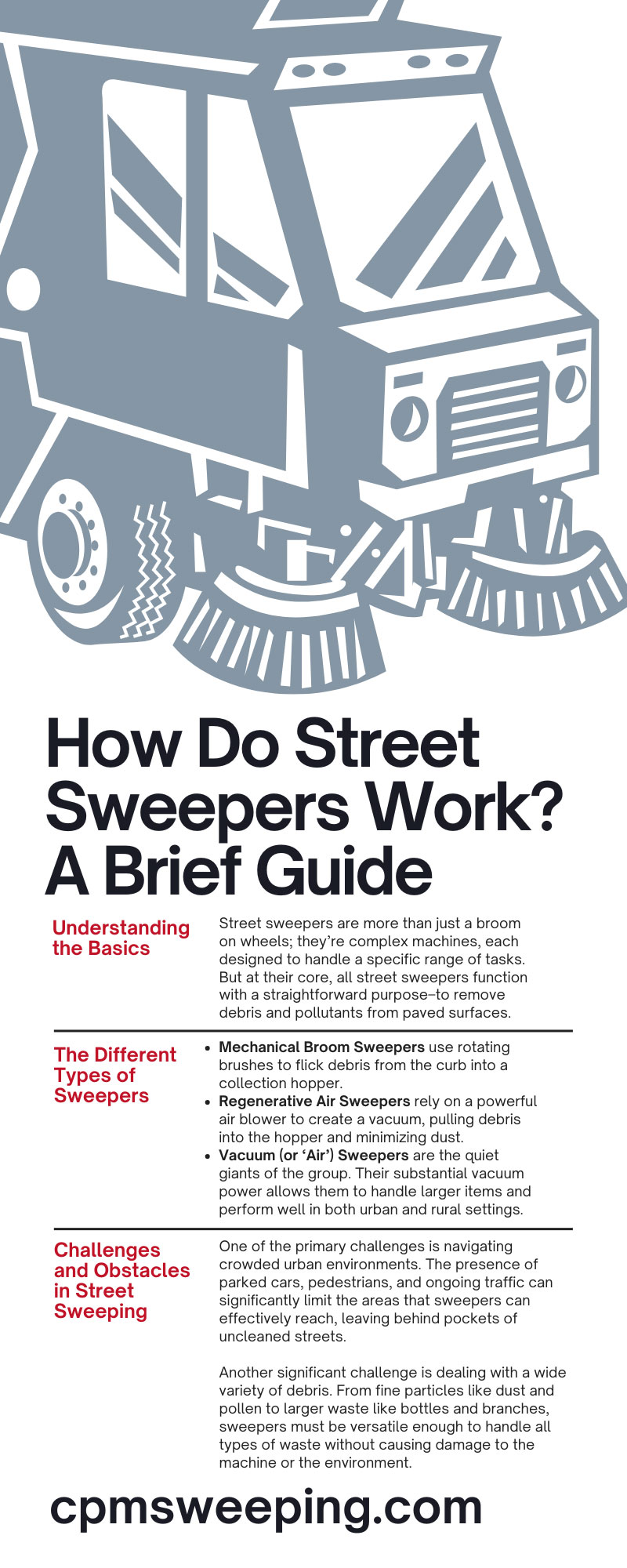Cleanliness is essential in every city, town, construction site, and parking lot. Streets and parking lots need a lot of attention to maintain a normal smooth operation appearance. But how does one clean up the mess that comes with regular use? Enter the street sweepers. For municipalities, construction managers, and urban planners, understanding the inner machinations of street sweeping is pivotal. Discover how street sweepers work, and more information in the blog below.
Understanding the Basics
So, how do street sweepers work? Let’s explore the answer to this question. Street sweepers are more than just a broom on wheels; they’re complex machines, each designed to handle a specific range of tasks. But at their core, all street sweepers function with a straightforward purpose–to remove debris and pollutants from paved surfaces.
The Different Types of Sweepers
It’s not a one-size-fits-all when it comes to street sweepers. There are three main types.
- Mechanical Broom Sweepers use rotating brushes to flick debris from the curb into a collection hopper.
- Regenerative Air Sweepers rely on a powerful air blower to create a vacuum, pulling debris into the hopper and minimizing dust.
- Vacuum (or ‘Air’) Sweepers are the quiet giants of the group. Their substantial vacuum power allows them to handle larger items and perform well in both urban and rural settings.
Regardless of the type, all modern sweepers aim for efficiency–covering maximum surface area in the least amount of time with minimal environmental impact.
Challenges and Obstacles in Street Sweeping
Though street sweepers play a crucial role in urban cleanliness and environmental health, they encounter several challenges and obstacles in their day-to-day operations. One of the primary challenges is navigating crowded urban environments. The presence of parked cars, pedestrians, and ongoing traffic can significantly limit the areas that sweepers can effectively reach, leaving behind pockets of uncleaned streets.
Another significant challenge is dealing with a wide variety of debris. From fine particles like dust and pollen to larger waste like bottles and branches, sweepers must be versatile enough to handle all types of waste without causing damage to the machine or the environment.
Weather conditions also pose a challenge to street sweeping efforts. Heavy rains can wash away debris and lead to clogged drains and flooded streets, making it difficult for sweepers to operate. On the other hand, extreme dry conditions can increase the amount of airborne dust during cleaning, which poses a health risk and undermines the area’s cleanliness.
The maintenance of the street sweepers themselves can be a daunting task. Given their complex machinery and the heavy workload, regular maintenance is crucial to ensure these vehicles operate efficiently and effectively. Without proper care, the performance of street sweepers can significantly decline, impacting the overall cleanliness of the urban landscape.
Navigating these challenges requires innovative solutions, adaptable strategies, and continuous improvement in street-sweeping technologies to ensure our cities remain clean, healthy, and vibrant.
Benefits of Street Sweeping
Street sweepers positively contribute to the environment, public health, and civic aesthetics in various ways. Let’s explore the multiple benefits street sweeping provides.
An Environmental Guardian
Dirt isn’t just a visual nuisance; it can contain heavy metals, trace chemicals, and other pollutants that, if left unattended, can leach into water systems and soil. Street sweepers play a vital role in reducing these contaminants and protecting our natural resources.
Health and Aesthetics
By sweeping away dust and dirt, you’re reducing the particulate matter in the air, which leads to improved air quality. Cleaner streets also greatly enhance the aesthetic appeal of any area, from the tranquil beauties of a rural lane to the neon pulse of a metropolitan district.
Street Sweeping Best Practices
It’s not just about the sweepers themselves but the strategy behind the clean. Here are some practices that can optimize the efficiency of your street-sweeping efforts.
Tailoring to Terrains
Tailor the type of street sweeper to the surrounding terrain. A larger, more powerful vehicle might not be as effective in narrow alleyways as in broad city squares. Tailoring the equipment to the terrain ensures an easier job where no sweeping goes to waste.
Scheduling for Success
Knowing when to sweep is just as important as knowing how. For example, certain locations will need night-time cleaning to minimize disruption. Scheduling also involves scheduling regular routine city street maintenance to maintain a baseline of cleanliness.
Communicating with the Community
Street sweeping often involves road closures or restrictions that can be inconvenient. Proactively letting the public know about the schedule is courteous and ensures cleaning effectiveness. A clean, strategic communication plan can greatly improve public satisfaction.
The Future of Street Sweeping
We’re not quite at the “self-cleaning streets” future envisioned in science fiction, but the street-sweeping industry isn’t one to fall behind in adopting technology.
Innovations in Waste Management
From onboard pollution sensors that measure the contents of the debris to automated auger systems that reduce the need for manual cleanouts, waste management innovations are rapidly advancing. These not only improve the efficiency of waste collection but also reduce workers’ exposure to potentially harmful material.
Data-Driven Cleaning
Smart sweepers use onboard computers and GPS to deliver real-time data on what’s already clean and what needs addressing. This technology also helps planners plan sweeping routes to minimize unnecessary travel.
Eco-Friendly Initiatives
The future of street sweeping propels sustainable practices. It helps ensure that the dirt, debris, and garbage from the streets don’t end up in the waterways. Electric and hybrid sweepers reduce emissions while implementing mechanical filters, which ensures only clean air returns to the environment.
A clean street may seem like a visual luxury, but it indicates a well-oiled machine of urban maintenance. From public health to environmental welfare, the benefits of employing street sweepers are as vast as the swathes of concrete and asphalt they clean. It’s easy to see the benefit of street sweepers when you understand how they work. It’s an evolving industry, integrating technology with an age-old necessity. The future of clean streets lies in our present, and it’s a path well-brushed by sweepers of all types.


